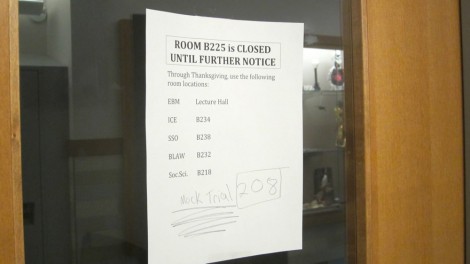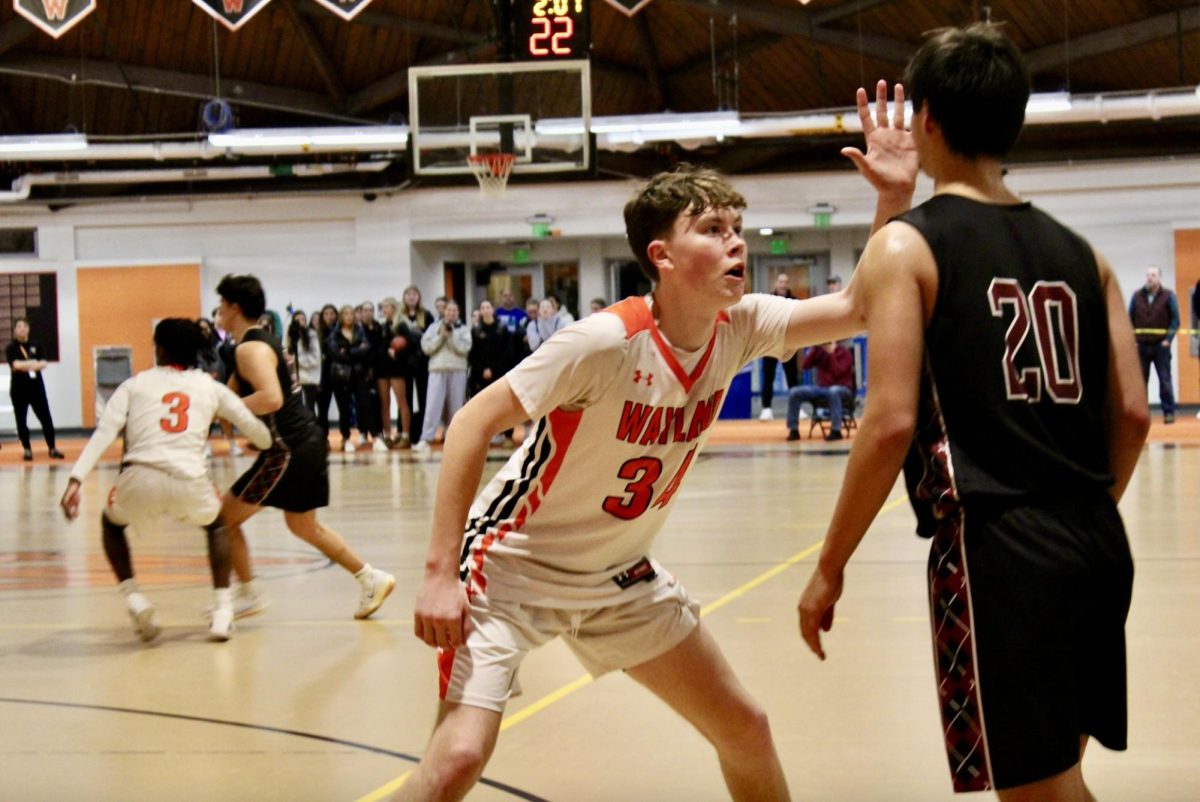
Mold was discovered in the WHS business lab in August. In November, the room was closed for a week.
On Nov. 20, the business lab, also known as room B225, was locked with the lights off. A sign on the door directed students to report to different rooms for class with no explanation.
As business teacher Jim Page was sitting in the room for a meeting, a janitor came in and put an “out of order” sign on the door.
“[He] told me that the classroom was to be fixed because there was mold,” Page said.
Three months earlier, in mid-August, Dean of Students Scott Parseghian and Principal John Ritchie were walking through the school when they noticed black spots in the room forming near the air conditioner. The custodians began cleaning the visible mold on the outside of the wall right away and also took down a portion of the ceiling, but the task wasn’t completed until after the school year started.
“I believe it was the first day of school, and there was a ladder still in my classroom, and the ceiling was still taken apart. When I inquired why, I found out [from Assistant Principal Allyson Mizoguchi] that it was being taken apart because of mold in the classroom,” Page said. “I assumed at that point that the problem had been solved, but apparently that was more of the investigation phase than the actual fixing of the problem.”
As of now, administration and the town facilities department believe that the mold was caused by condensation build up from the air conditioner. According to Parseghian, typically, a normal air conditioner will produce water, which goes through a hose that is drained below the school.
“The line on [the AC] was kinked, so the water kind of flowed out, and that caused black spots to appear,” Facilities Manager Pat Morris said.
Morris requested Envirotest Laboratory, a company that specializes in mold testing, inspection and remediation, to inspect the room. On Aug. 19, Envirotest conducted an air quality and environment test of the room to see what further actions needed to be taken.
According to the report, “The airborne levels of mold were slightly elevated and found to be comprised of mold types which indicate that immediate action be taken to remedy the mold problem.”
The report identified Penicillium and Aspergillus as two types of mold in the room. Wipe results from the report indicated that the surface fungal levels for these two spores were at 25,000 CFU/m3 in August. A CFU is a colony forming unit or a live or growing colony of a specific type of fungus. Samples above 1000 CFU/m3 are considered to be excessively concentrated with mold.
The appendix in the report states that while neither Penicillium nor Aspergillus are life-threatening fungi, they can both trigger allergy symptoms, particularly Aspergillus, which is a fairly common environmental fungus.
Specifically, the report states, “health problems due to Aspergillus exposure may include headaches, eye, and skin irritation, asthma aggravation of existing respiratory conditions, other typical allergic symptoms, and hypersensitivity pneumonitis.”
The report recommended that the leak in the air conditioner be repaired, a mold removal professional remove the wall and spray a mold inhibitor and fungicide into the wall and then replace the wall with Hardiboard material.
While the room was closed, an Envirotest crew began removing the mold on Nov. 20 from the right side of room. On Nov. 22, Envirotest conducted another air quality test to see if all of the mold had been abated. The report came back clean and states, “the airborne levels of mold were normal and found to be comprised of typical mold types for normal functioning property” and that “at the time of the inspection, there were no qualitative or quantitative air quality issues identified that needed to be addressed or remediated.”
However, despite the fact that the room is now considered clean, the length of the mold removal process has raised some questions.
“I was bothered that something that was supposed to require immediate action took three months,” Page said.
Although the report was made in August, Morris did not receive it until the week of Nov. 18, which is why the room wasn’t closed until then.
“The report is dated in mid-August, but we never actually received it,” Mizoguchi said. “Morris called [Envirotest] and said ‘where’s the report?’ They sent it as soon as we requested it. They just had either never sent it or it got lost in the mail.”
According to Superintendent Paul Stein, Envirotest was working on another project in Wayland, and that’s what reminded Morris that he had not received the report yet and prompted him to call Envirotest three weeks ago.
“We still don’t know why there was a delay,” Stein said. “The person who is in charge of facilities in town contacted the company last week, and he said he needs an explanation because this is a matter of great concern that this amount of time would go by. We’re at the point of waiting for the company to see what its explanation is.”
“I guess we were lucky because we saw the black dots, and that’s what made us look into it,” Parseghian said. “I think we acted accordingly and took care of it.”





![Last Wednesday, the Wayland School Committee gathered to discuss a number of topics regarding the health curriculum and Innovation Career Pathway course. Another large topic of conversation was the ways to potentially mitigate distracting cell phone usage. "These [phones] are going to distract your learning and social relationships," Superintendent David Fleishman said. "That's concrete right there."](https://waylandstudentpress.com/wp-content/uploads/2025/06/Screenshot-2025-06-04-at-9.49.31 PM-1200x886.png)






























Truman • Jan 22, 2014 at 2:24 PM
sad
Insider • Dec 18, 2013 at 11:44 PM
Coach P is an Assistant Principal now, not Dean of Students
WHS Student • Dec 13, 2013 at 7:33 PM
Now we just sit back and wait for the lawsuit…
Lookin @ you mock trial